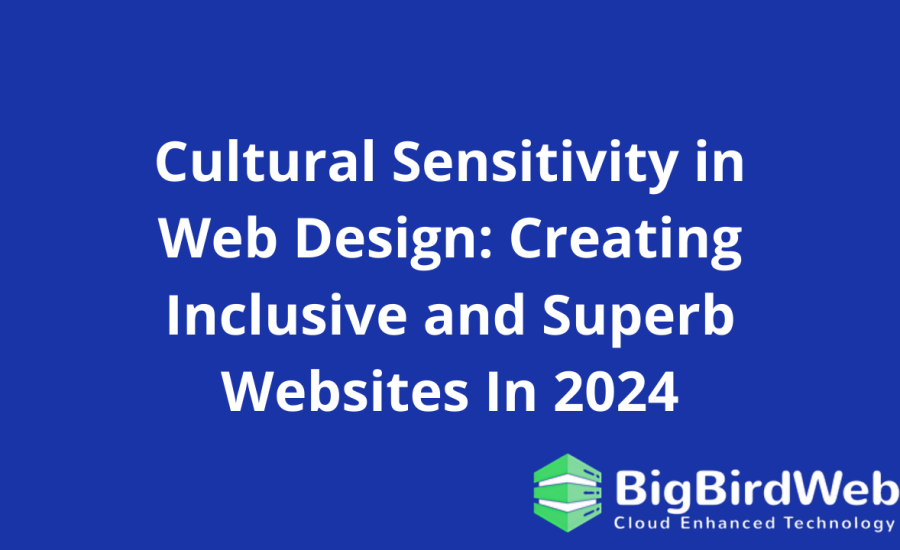In today’s digital age, cultural sensitivity has become a crucial component of effective web design. This is especially pertinent in a diverse and multicultural country like India, where a single website may cater to a myriad of languages, traditions, and customs. At Bigbirdweb, we are committed to ensuring that our web design practices are inclusive and accessible, reflecting a global reach that resonates with every user. This blog explores why cultural sensitivity matters, how to implement it in web design, and offers actionable insights to create websites that cater to diverse audiences.

Table of Contents
Why Cultural Sensitivity Matters in Web Design

Cultural sensitivity in web design is about understanding and addressing the diverse cultural backgrounds of your users. In a country like India, where cultural diversity is immense, failing to consider these differences can lead to a disconnect between your website and its audience. This disconnect can result in lower user engagement, reduced accessibility, and a missed opportunity to connect with a broader audience.
- Enhances User Experience: Websites that respect and reflect cultural nuances create a more engaging and relevant user experience. For instance, color symbolism varies across cultures—what may be considered auspicious in one culture could be seen as inappropriate in another. By incorporating culturally appropriate design elements, websites can provide a more personalized and respectful experience.
- Boosts Accessibility: Accessibility is a key aspect of web design that overlaps with cultural sensitive hosting. A website that is accessible to people with disabilities is also more likely to be culturally inclusive. This includes providing alternative text for images, ensuring readable fonts, and designing for screen readers.
- Increases Global Reach: For businesses aiming to operate on an international scale, cultural sensitivity is vital. It helps in creating content that resonates with users from different cultural backgrounds, which can drive global engagement and foster positive brand perceptions. You can also opt for free web hosting.
Key Aspects of Cultural Sensitivity in Web Design
To design websites that are both inclusive and accessible, consider the following key aspects:
1. Language and Localization
Cultural sensitivity involves understanding the language preferences of your audience. In India, where multiple languages are spoken, it’s essential to offer multilingual support. Localization goes beyond mere translation; it involves adapting the content to fit cultural norms and preferences.
- Language Selection: Provide options for users to choose their preferred language. Ensure that translations are accurate and culturally appropriate, avoiding direct translations that may not convey the intended meaning.
- Cultural Context: Tailor content to reflect cultural nuances. For example, festival greetings or cultural references should be relevant to the user’s background.
2. Visual Design and Color Usage
Colors and visual elements can have different meanings across cultures. Being aware of these differences helps in designing websites that are visually appealing to a diverse audience.
- Color Symbolism: Research color meanings in various cultures. For instance, while red may symbolize prosperity in India, it might signify danger or warning in other cultures. Choose colors that align with your brand message and are universally acceptable.
- Imagery and Icons: Use images and icons that represent diverse cultures and avoid stereotypes. This includes featuring people of various ethnic backgrounds and avoiding imagery that could be considered offensive or insensitive.
3. Layout and Navigation
A website’s layout and navigation should be intuitive and culturally relevant. Consider how different cultures interact with web interfaces and adapt your design accordingly.
- Navigation Patterns: Different cultures may have varying preferences for navigation styles. For instance, users from Western cultures often expect a left-to-right navigation flow, while users from other cultures might prefer different arrangements.
- Content Hierarchy: Organize content in a way that aligns with cultural expectations. Ensure that important information is easily accessible and presented in a logical sequence.
4. Accessibility Features
Incorporating accessibility features is not only a best practice but also a reflection of cultural sensitivity. Ensure that your website is usable by people with disabilities, which includes:
- Alternative Text: Provide descriptive alternative text for images, so users with visual impairments can understand the content.
- Keyboard Navigation: Ensure that users can navigate the website using a keyboard, accommodating those who may not use a mouse.
- Contrast and Readability: Use high-contrast colors for text and background to improve readability for users with visual impairments.
5. Content Sensitivity
Content on your website should be crafted with sensitivity to cultural and social norms. This involves:
- Avoiding Offensive Content: Steer clear of content that could be considered offensive or controversial in any culture. This includes sensitive topics such as religion, politics, and social issues.
- Inclusive Language: Use language that is inclusive and respectful. Avoid jargon or terminology that might be unfamiliar or exclusionary to some users.
Practical Steps for Implementing Cultural Sensitivity
Implementing cultural sensitivity in web design involves a combination of research, design practices, and continuous feedback. Here are some practical steps to guide you:
- Conduct Cultural Research: Before starting the design process, research the cultural backgrounds of your target audience. Understand their preferences, values, and potential sensitivities.
- Involve Local Experts: Collaborate with local cultural experts or consultants to ensure that your design choices are appropriate and respectful.
- Test with Diverse Users: Conduct usability testing with users from various cultural backgrounds. Gather feedback to identify any issues or areas for improvement.
- Regular Updates: Continuously update your website to reflect cultural changes and user feedback. This ensures that your site remains relevant and inclusive over time.
Bigbirdweb’s Commitment to Inclusivity
At Bigbirdweb, we are dedicated to creating websites that reflect our commitment to inclusivity and global reach. Our approach to cultural sensitivity involves a thorough understanding of diverse cultures and incorporating this knowledge into every aspect of our web design process. From multilingual support to accessible design features, we strive to ensure that our websites are engaging and respectful to users from all backgrounds.
FAQs
1. What is cultural sensitivity in web design?
Cultural sensitivity in web design refers to the practice of understanding and addressing the diverse cultural backgrounds of users to create an inclusive and respectful online experience.
2. Why is cultural sensitivity important for Indian websites?
India’s diverse cultural landscape necessitates cultural sensitivity to ensure that websites resonate with users from various linguistic and cultural backgrounds, enhancing user engagement and accessibility.
3. How can I make my website more culturally sensitive?
You can make your website more culturally sensitive by offering multilingual support, using culturally appropriate colors and imagery, designing intuitive navigation, and including accessibility features.
4. What are some best practices for designing accessible websites?
Best practices include providing alternative text for images, ensuring high-contrast text, enabling keyboard navigation, and avoiding content that could be considered offensive or exclusionary.
5. How does Bigbirdweb ensure cultural sensitivity in its web design?
Bigbirdweb ensures cultural sensitivity by conducting cultural research, collaborating with local experts, testing with diverse users, and continuously updating websites based on feedback and cultural changes.
Cultural Sensitivity in Web Design in India: Creating Inclusive and Accessible Websites
In today’s digital age, cultural sensitivity is not just a nice-to-have; it’s a necessity for successful web design. This is especially true in a diverse country like India, where cultural nuances, linguistic diversity, and regional differences play a significant role in how users interact with digital content. At Bigbirdweb, our commitment to cultural sensitivity ensures that every website we design is inclusive, accessible, and resonates with a global audience. In this extended discussion, we’ll delve deeper into the importance of cultural sensitivity and how to practically implement it in web design, focusing on the Indian context.
The Importance of Cultural Sensitivity in Web Design
Cultural sensitivity involves more than just avoiding offensive content; it’s about creating a web experience that acknowledges and respects the diverse backgrounds of users. This sensitivity is crucial for several reasons:
- User Engagement: Websites that reflect an understanding of cultural differences are more likely to engage users. When users feel that a website respects their cultural background, they are more likely to spend time on it and interact with its content.
- Brand Reputation: A website that demonstrates cultural sensitivity enhances brand reputation. It shows that the brand is aware of and respects cultural differences, which can lead to increased trust and loyalty among users.
- Market Reach: For businesses looking to expand their reach, cultural sensitivity is key to tapping into new markets. By designing websites that cater to various cultural contexts, businesses can attract and retain a more diverse audience.
Deep Dive into Cultural Sensitivity Practices
1. Multilingual Support and Localization
Multilingual support is more than just translating text. It involves localization, which tailors content to fit the cultural and linguistic nuances of different regions. Here’s how to approach it:
- Language Selection: Offer language options that cater to the linguistic diversity in India. Besides major languages like Hindi, English, and regional languages such as Tamil, Bengali, and Marathi, consider including local dialects if relevant.
- Cultural Context: Ensure that translations are culturally relevant. This means adapting idioms, humor, and references to fit the local culture. Direct translations often fail to capture the essence of the message, leading to confusion or misinterpretation.
- Date and Time Formats: Adjust date and time formats to match local conventions. For example, the date format in India is typically DD/MM/YYYY, whereas other countries might use MM/DD/YYYY.
2. Visual Design and Color Sensitivity
Colors play a significant role in cultural perceptions. What is considered auspicious or favorable in one culture might be interpreted differently in another. Here’s how to handle color sensitivity:
- Color Meanings: Research color meanings and their impact in different cultures. In India, colors like saffron and green have specific cultural and religious connotations. For example, saffron is associated with spirituality, while green represents prosperity.
- Design Consistency: Ensure that your color choices are consistent with your brand’s message while respecting cultural norms. Avoid using colors that could be seen as negative or inappropriate in the target culture.
- Imagery and Icons: Use imagery that is diverse and representative of different cultures. Avoid stereotypes and ensure that icons and symbols are culturally appropriate and easily understood by users from different backgrounds.
3. Navigational Design and User Interaction
Navigation patterns and user interactions can vary based on cultural preferences. To create a user-friendly experience:
- Navigation Styles: Different cultures may have different expectations for navigation. For instance, Western users are accustomed to left-to-right navigation, while some other cultures might prefer different layouts. Make sure the navigation is intuitive and aligns with user expectations.
- Content Hierarchy: Organize content in a way that prioritizes what is most relevant to the user. This might vary based on cultural norms and user behaviors. For example, in some cultures, visual content may take precedence over text, while in others, detailed textual information might be preferred.
4. Accessibility and Inclusivity
Cultural sensitivity and accessibility go hand in hand. A website that is accessible to all users, including those with disabilities, reflects a commitment to inclusivity. Key accessibility features include:
- Alternative Text for Images: Provide descriptive alternative text for all images. This helps users with visual impairments understand the content and context of the images.
- Keyboard Navigation: Ensure that all website functionalities are accessible via keyboard navigation. This is crucial for users who may not use a mouse due to physical disabilities.
- Readable Fonts and Contrast: Use high-contrast color combinations for text and backgrounds to improve readability. Ensure that font sizes are adjustable and that the text is easy to read for users with visual impairments.
5. Content Sensitivity and Relevance
The content on your website should be crafted with care to avoid offending any cultural or social groups. This involves:
- Avoiding Sensitive Topics: Steer clear of content that may be sensitive or controversial, such as topics related to religion, politics, or social issues, unless it is directly relevant and handled with great care.
- Inclusive Language: Use language that is inclusive and respectful. Avoid jargon or terminology that may be unfamiliar or exclusionary to certain groups. Ensure that your content resonates with a wide audience without being offensive or alienating.
Implementing Cultural Sensitivity: A Step-by-Step Approach
- Research and Planning: Begin by researching the cultural backgrounds of your target audience. Understand their preferences, values, and any potential sensitivities. This research should guide your design and content decisions.
- Design Development: Apply your research findings to the design process. Choose colors, imagery, and layout options that align with cultural norms and preferences. Develop content that is relevant and respectful to diverse audiences.
- Testing and Feedback: Conduct usability testing with a diverse group of users. Gather feedback on the design’s effectiveness and cultural appropriateness. Use this feedback to make necessary adjustments.
- Continuous Improvement: Regularly update your website based on user feedback and evolving cultural contexts. Stay informed about cultural trends and changes to ensure your website remains inclusive and relevant.
Bigbirdweb’s Approach to Cultural Sensitivity
At Bigbirdweb, our approach to cultural sensitivity is embedded in every stage of the web design process. We prioritize understanding the cultural contexts of our clients’ target audiences, ensuring that our designs are both inclusive and engaging. By combining cultural research, expert consultation, and user feedback, we create websites that resonate with users from diverse backgrounds and reflect our commitment to global reach.
FAQs
1. What is cultural sensitivity in web design?
Cultural sensitivity in web design involves understanding and addressing the diverse cultural backgrounds of users. It ensures that the website is inclusive and respectful to people from different cultural contexts, enhancing user experience and accessibility.
2. Why is cultural sensitivity particularly important for Indian websites?
India is a country with immense cultural diversity, including various languages, traditions, and customs. Cultural sensitivity ensures that websites are designed to resonate with this diverse audience, fostering better engagement and understanding.
3. How can I make my website more culturally sensitive?
To enhance cultural sensitivity, you can:
- Offer multilingual support and accurate translations.
- Use culturally appropriate colors, images, and icons.
- Design intuitive navigation that aligns with cultural preferences.
- Ensure accessibility features for users with disabilities.
4. What are some best practices for designing accessible websites?
Best practices include:
- Providing descriptive alternative text for images.
- Ensuring high-contrast text and background combinations.
- Designing for keyboard navigation.
- Avoiding content that may be offensive or exclusionary.
5. How does Bigbirdweb ensure *cultural sensitivity* in its web design?**
Bigbirdweb ensures cultural sensitivity by:
- Conducting thorough cultural research.
- Collaborating with local experts and consultants.
- Testing designs with diverse user groups.
- Continuously updating websites based on feedback and evolving cultural contexts.
Bonus Content
Top Tools for Enhancing *Cultural Sensitivity* in Web Design
- Google Translate: Useful for providing multilingual support and verifying translations. While not perfect, it can assist in reaching a broader audience by offering basic translations.
- Color Theory Tools: Tools like Adobe Color or Coolors can help you understand color meanings in different cultures. This can guide you in choosing color schemes that are culturally appropriate.
- Accessibility Checkers: Tools such as WAVE, Axe, or Lighthouse can help you assess and improve the accessibility of your website. Ensuring that your website is accessible is a key aspect of being culturally sensitive.
- User Testing Platforms: Platforms like UserTesting or TryMyUI allow you to gather feedback from users from various cultural backgrounds. This helps in identifying potential issues and making necessary adjustments.
- Cultural Sensitivity Guides: Refer to online guides or consult with cultural experts who can provide insights into specific cultural norms and practices. This knowledge is invaluable for making informed design decisions.
By integrating these tools and practices into your web design process, you can create a website that is not only visually appealing but also inclusive and respectful of diverse cultural contexts. This commitment to cultural sensitivity will help you build stronger connections with your audience and enhance your website’s global reach.
